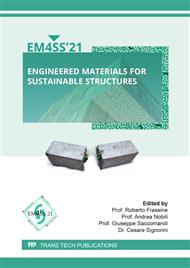[1]
V.M. Malhotra, Role of supplementary cementing materials in reducing greenhouse gas emissions. In: Gjorv OE, Sakai K, editors. Concrete technology for a sustainable development in the 21st century, London, (2000).
DOI: 10.1201/9781482272215-23
Google Scholar
[2]
C. Signorini, A. Nobili, C. Siligardi, Sustainable mineral coating of alkali-resistant glass fibres in textile-reinforced mortar composites for structural purposes, Journal of composite materials 53 (2019) 4203-4213.
DOI: 10.1177/0021998319855765
Google Scholar
[3]
H. Hu, P. Papastergiou, H. Angelakopoulos, M. Guadagnini, K. Pilakoutas, Mechanical properties of SFRC using blended manufactured and recycled tyre steel fibres. Constr. Build. Mater. 163 (2018) 376-389.
DOI: 10.1016/j.conbuildmat.2017.12.116
Google Scholar
[4]
G. Centonze, M. Leone, M. Aiello, Steel fibers from waste tires as reinforcement in concrete: A mechanical characterization, Constr. Build. Mater. 36 (2012) 46-57.
DOI: 10.1016/j.conbuildmat.2012.04.088
Google Scholar
[5]
T. Ochi, S. Okubo, K. Fukui, Development of recycled PET fiber and its application as concrete-reinforcing fiber, Cem. Concr. Compos. 29 (2007) 448-455.
DOI: 10.1016/j.cemconcomp.2007.02.002
Google Scholar
[6]
C. Signorini, V. Volpini, Mechanical Performance of Fiber Reinforced Cement Composites Including Fully-Recycled Plastic Fibers, Fibers, 9(3) (2021) 16.
DOI: 10.3390/fib9030016
Google Scholar
[7]
C. Signorini, A. Nobili, Durability of fibre-reinforced cementitious composites (FRCC) including recycled synthetic fibres and rubber aggregates, Applications in Engineering Science, 9(2022).
DOI: 10.1016/j.apples.2021.100077
Google Scholar
[8]
H. Savastano, S.F. Santos, M. Radonjic, W.O. Soboyejo, Fracture and fatigue of natural fiber-reinforced cementitious composites, Cement and Concrete Composites, 31(4) (2009) 232-243.
DOI: 10.1016/j.cemconcomp.2009.02.006
Google Scholar
[9]
F. D'Alessandro, F. Asdrubali, G. Baldinelli, Multi-parametric characterization of a sustainable lightweight concrete containing polymers derived from electric wires, Construction and Building Materials 68 (2014) 277-284.
DOI: 10.1016/j.conbuildmat.2014.06.075
Google Scholar
[10]
A. Moreira, J. António, A. Tadeu, Lightweight screed containing cork granules: Mechanical and hygrothermal characterization, Cement and Concrete Composites 49 (2014) 1-8.
DOI: 10.1016/j.cemconcomp.2014.01.012
Google Scholar
[11]
A. Tadeu, A. Moreira, J. António, N. Simões, I. Simões, Thermal delay provided by floors containing layers that incorporate expanded cork granule waste, Energy and Buildings, 68 (2014) 611-619.
DOI: 10.1016/j.enbuild.2013.10.007
Google Scholar
[12]
P. Reiterman, O. Holčapek, O. Zobal, M. Keppert, Freeze-Thaw Resistance of Cement Screed with Various Supplementary Cementitious Materials, Reviews on advanced materials science, 58(1) (2019) 66-74.
DOI: 10.1515/rams-2019-0006
Google Scholar
[13]
M.C.G. Juenger, F. Winnefeld, J.L. Provis, J.H Ideker, Advances in alternative cementitious binders, Cem. Concr. Res. 41(12) (2011) 1232-43.
DOI: 10.1016/j.cemconres.2010.11.012
Google Scholar
[14]
H. Beshr, A. A. Almusallam, M. Maslehuddin, Effect of coarse aggregate quality on the mechanical properties of high strength concrete, Construction and building materials 17(2) (2003) 97-103.
DOI: 10.1016/s0950-0618(02)00097-1
Google Scholar
[15]
EN 13813, Screed material and floor screeds - Screed material - Properties and requirements, CEN European Committee for Standardization, (2002).
DOI: 10.3403/02690071u
Google Scholar
[16]
EN 196-1, Methods of testing cement - Part 1: Determination of strength, CEN European Committee for Standardization, (2016).
Google Scholar
[17]
EN 13656, Characterization of waste - Microwave assisted digestion with hydrofluoric (HF), nitric (HNO3) and hydrochloric (HCl) acid mixture for subsequent, CEN European Committee for Standardization, (2002).
DOI: 10.3403/02675724
Google Scholar
[18]
EN 14346, Characterization of waste - Calculation of dry matter by determination of dry residue or water content, CEN European Committee for Standardization, (2006).
DOI: 10.3403/30067860u
Google Scholar
[19]
CNR-IRSA 2Q64, Metodi analitici per i fanghi, quaderno n. 64.
Google Scholar
[20]
EN 12457-2, Characterisation of waste - Leaching - Compliance test for leaching of granular waste materials and sludges - Part 2: One stage batch test at a liquid to solid ratio of 10 l/kg for materials with particle size below 4 mm (without or with size reduction), CEN European Committee for Standardization, (2002).
DOI: 10.3403/02667193
Google Scholar
[21]
V. Ramasamy, P. Rajkumar, V. Ponnusamy, Depth wise analysis of recently excavated Vellar river sediments through FTIR and XRD studies, Indian journal of physics 83(9) (2009) 1295-1308.
DOI: 10.1007/s12648-009-0110-3
Google Scholar
[22]
Y. Ke, A.L. Beaucour, S. Ortola, H. Dumontet, R. Cabrillac, Influence of volume fraction and characteristics of lightweight aggregates on the mechanical properties of concrete. Construction and Building Materials, 23(8) (2009) 2821-2828.
DOI: 10.1016/j.conbuildmat.2009.02.038
Google Scholar


